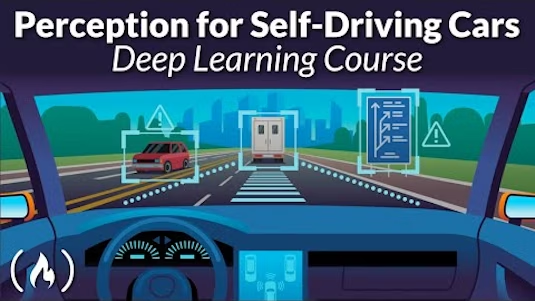Notes and key takeaways of the Self-Driving Cars Perception and Deep Learning Free Course from freeCodeCamp.org.
Learn some computer vision core tasks for self-driving cars perception stack using deep learning, including road segmentation, object detection and tracking, and 3D data visualization.
Prerequisites
- ~2 hours
- Free course (No certificate awarded)
- Intermediate level: Python and deep learning (required)
Instructor
- Sakshay Mahna from (Robotics with Sakshay)
Course Objectives
- Gain a comprehensive understanding of the key computer vision tasks involved in self-driving car perception
- Deepen knowledge of deep learning techniques, particularly Convolutional Neural Networks (CNNs), for addressing these tasks
- Learn how to implement and evaluate deep learning models for road segmentation, object detection, tracking, and camera to bird's eye view (BEV) mapping
- Acquire hands-on experience with real-world data and popular deep learning libraries
- 00 - Introduction
- 01 - Road Segmentation | Fully Convolutional Network (FCN)
- 02 - 2D Object Detection | YOLO
- 03 - Object Tracking | Deep SORT
- 04 - 3D Data Visualization | Homogenous Transformations | KITTI
- 05 - Multi Task Learning | Multi Task Attention Network (MTAN)
- 06 - 3D Object Detection | SFA 3D
- 07 - Camera to Bird's Eye View | UNetXST
Read the courses Online, you can visit Perception for Self-Driving Cars Applied Deep Learning.
Happy Learning!
- Feel free to open a PR or an issue if you encounter some problem running the projects.
Here's how you can contribute:
- Fork this repository and clone it to your local machine.
- Create a new branch with a descriptive name for your contribution.
- Add your code and files to the branch and commit your changes.
- Push your branch to your forked repository and create a pull request to the main repository.
- Wait for your pull request to be reviewed and merged.
Full course link:
- freeCodeCamp - Computer Vision and Perception for Self-Driving Cars (Deep Learning Course)
- Class central - (great to follow with split section)
Other related courses:
Zero (Beginner):
- Introduction to Computer Vision - Udacity (Beginner)
- Introduction to Computer Vision for Self-Driving Cars - thinkautonomous
- Computer Vision Kaggle Free Course
Apprentice (Intermediate):
- The Complete Self-Driving Cars course applied Deep Learning - Udemy
- Deep Learning for Autonomous Vehicles - Perception - NVIDIA
Hero (Advanced):
- Advanced Computer Vision with TensorFlow - DeepLearningAI & Class Central
- Visual Perception - Self-Driving Specialization - University of Toronto
- Introduction to Computer Vision (Advanced)
- Udacity Computer Vision Nano Degree Program
- Advanced Computer Vision and Deep Learning - Udacity

